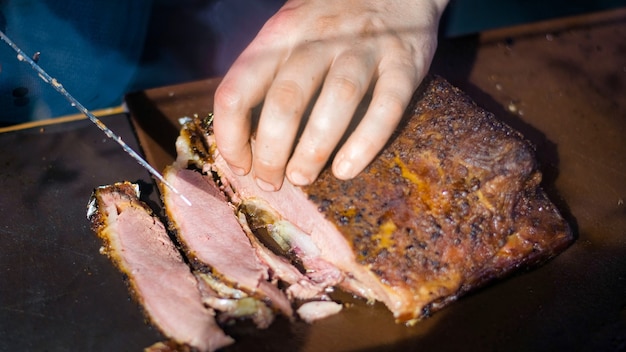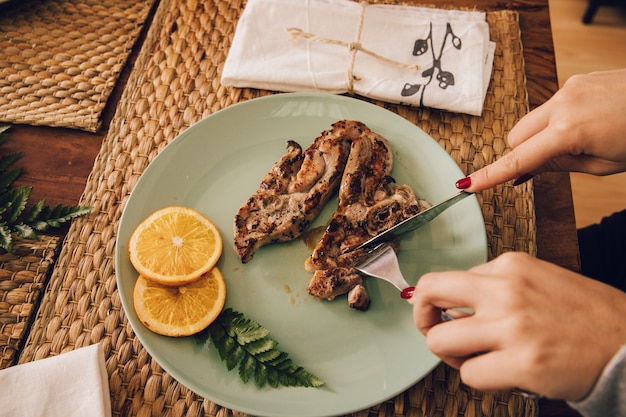Ah, the sweet symphony of smoky, succulent BBQ beef tenderloin! There's a reason this dish is a summertime staple - it's a guaranteed crowd-pleaser, perfect for those laid-back afternoons spent with good friends and good company. But let me tell you, a perfectly cooked BBQ beef tenderloin isn't just about throwing a piece of meat on the grill and calling it a day. There's a real art to it, a delicate dance of heat, time, and seasoning that transforms a humble piece of beef into a culinary masterpiece. Over the years, I've experimented, honed my skills, and learned a thing or two about achieving that elusive tender, juicy perfection. So grab a cold drink, relax, and let's dive into this ultimate guide!
(Part 1) Choosing the Right Beef

The Star of the Show
Let's face it, a good BBQ beef tenderloin starts with a good quality piece of meat. Now, I'm not saying you have to break the bank, but investing in a decent cut is essential. The tenderloin is the most tender cut of beef, with a delicate flavour that's just begging to be enhanced by those smoky BBQ flavours. It's a piece of meat that melts in your mouth, leaving a lingering taste of pure satisfaction.
Understanding Your Options
There are two main types of tenderloins: centre-cut and tail-end. Centre-cut is the most popular, as it's typically thicker and more evenly shaped, making it ideal for grilling. Tail-end, on the other hand, is a bit leaner, but still delicious! When choosing, look for a tenderloin that's uniformly thick with minimal fat marbling. This helps ensure even cooking and prevents any dry or tough spots.
Size Matters
Deciding on the size depends on your guest list. For a smaller gathering, a 2-3 pound tenderloin should be perfect. For a larger group, go for a 4-5 pounder. And remember, leftovers are always welcome!
(Part 2) Prepping for Perfection

Trim, Tie, and Season
Once you've got your chosen tenderloin, it's time to get our hands dirty. First, trim any excess fat. You can leave a thin layer, but I prefer to trim it down to a sliver, as it ensures even cooking and prevents the fat from rendering too much.
Next, tie the tenderloin. This helps maintain its shape and ensures consistent cooking throughout. Butcher's twine is ideal, but kitchen string will do the trick in a pinch. Tie it tightly, but not too tight, as you don't want to squeeze out the juices.
A Symphony of Flavors
Now, onto the fun part: seasoning! This is where you can unleash your culinary creativity. For a classic BBQ flavour, a simple blend of salt, black pepper, paprika, and garlic powder will do wonders. But feel free to experiment. I've been known to add a pinch of cayenne for a touch of heat, or some brown sugar for a hint of sweetness. Remember, the best BBQ rubs are those that reflect your personal preferences.
Embrace the Rest
Before firing up the grill, let your seasoned tenderloin rest at room temperature for 30-45 minutes. This allows the meat to come to a uniform temperature, which leads to more even cooking. Think of it as giving your beef a chance to unwind before the main event.
(Part 3) The Art of Grilling

Prepare Your Canvas
Alright, the stage is set. Now, we need to get our grill nice and hot. We're talking high heat, around 500-550 degrees Fahrenheit. For charcoal grills, let the coals burn down to glowing embers before placing the tenderloin on the grill.
A Gentle Touch
Place your tenderloin on the grill grate, making sure it's not directly over the hottest flames. You want to sear the outside without burning it before the inside has a chance to cook through. Cook for about 5-7 minutes per side, or until you see a nice crust forming.
Time for a Siesta
After you've seared the outside, move your tenderloin to a cooler part of the grill, or lower the heat to medium. Close the lid and let it cook for another 10-15 minutes, or until the internal temperature reaches 135 degrees Fahrenheit for medium-rare.
Don’t Overdo It
Remember, a well-done tenderloin is a tough and dry one. Nobody wants that! If you're unsure about the doneness, always err on the side of caution.
(Part 4) Resting and Slicing
Patience is a Virtue
Once your tenderloin has reached the desired internal temperature, resist the urge to carve it immediately. Let it rest for at least 10 minutes, covered with foil. This allows the juices to redistribute throughout the meat, creating a more tender and juicy final product.
Carving Like a Pro
After the resting period, you're finally ready to carve your masterpiece. Use a sharp knife to slice the tenderloin against the grain. This creates more tender, bite-sized pieces and unlocks the full potential of the tenderloin's texture. Don't be shy about slicing it generously.
(Part 5) Sauce Up the Flavor
A Symphony of Sauce
Now, it's time for the grand finale: a delicious bbq sauce. The beauty of this step is that you can choose a sauce that reflects your personal preferences. I'm a sucker for a classic smoky BBQ sauce, but there's a world of flavours out there, from tangy vinegar-based sauces to sweet and spicy options.
Brush, Glaze, and Sizzle
Once you've chosen your sauce, brush it generously over the tenderloin. You can apply it immediately after carving, or brush it during the final stages of grilling for a nice, sticky glaze. Just be careful, as the sauce can burn easily.
(Part 6) side dishes to Delight
A Feast for the Senses
No BBQ beef tenderloin would be complete without a selection of delicious side dishes. The options are endless, but here are a few of my personal favourites:
- corn on the cob: A classic BBQ staple that adds a sweet and smoky flavour to the meal. I love to grill it alongside the tenderloin, giving it a nice char.
- potato salad: A creamy and refreshing side dish that complements the rich flavours of the tenderloin. I like to make mine with a tangy mustard dressing.
- Coleslaw: A crunchy and tangy salad that provides a welcome contrast to the richness of the meat. I'm partial to a coleslaw with a light and creamy dressing.
- grilled vegetables: A healthy and flavorful side dish that's easy to prepare. I love to grill bell peppers, onions, and zucchini for a vibrant medley of colours and textures.
(Part 7) Tips for Success
- Don’t Overcook: It's always better to err on the side of undercooked than overcooked when it comes to beef tenderloin. Remember, you can always cook it a little longer, but you can't uncook it. It's better to have a slightly pink centre than a dry, tough piece of meat.
- Use a meat thermometer: This is essential for ensuring that your tenderloin is cooked to your desired level of doneness. You can find a meat thermometer at most grocery stores.
- Let It Rest: Allowing the tenderloin to rest after cooking is crucial for achieving a tender and juicy final product. It allows the juices to redistribute throughout the meat.
- Don’t Be Afraid to Experiment: When it comes to BBQ sauce, the possibilities are endless. Try different flavors and combinations to find what you like best. Remember, a good BBQ sauce is like a personal signature, reflecting your own unique taste.
(Part 8) FAQs
- How do I choose a good quality beef tenderloin? Look for a piece that is uniformly thick, with minimal fat marbling. The meat should be firm and have a bright red colour. Avoid any tenderloins that have a dry, greyish appearance.
- What is the best way to cook BBQ beef tenderloin? I recommend grilling it over medium heat for 10-15 minutes, or until the internal temperature reaches 135 degrees Fahrenheit for medium-rare. Be sure to let it rest for at least 10 minutes before slicing.
- What kind of BBQ sauce should I use? It really depends on your personal preferences. I love a classic smoky BBQ sauce, but there are many other delicious options available. Experiment with different flavors and combinations to find your favorite.
- What are some good side dishes to serve with BBQ beef tenderloin? Corn on the cob, potato salad, coleslaw, and grilled vegetables are all classic choices. But feel free to get creative and serve whatever you enjoy.
- Can I make BBQ beef tenderloin ahead of time? Yes, you can cook the tenderloin ahead of time and reheat it before serving. Simply store it in the refrigerator for up to 3 days, and reheat it in a preheated oven at 350 degrees fahrenheit for 15-20 minutes. Just be sure to reheat it thoroughly to ensure food safety.
(Part 9) Memories to Savour
A Feast for the Soul
There's something special about grilling a BBQ beef tenderloin. It's not just about the delicious food, it's about the atmosphere, the laughter, and the shared experience. It's about creating memories, enjoying good company, and celebrating the simple joys of life. And that, my friends, is what truly makes it the ultimate guide to tender, juicy perfection. So fire up the grill, gather your loved ones, and get ready for a BBQ feast that will be remembered for years to come.
Everyone is watching

How to Cook Frozen Lobster Tails Perfectly: A Step-by-Step Guide
RecipesLobster. Just the word conjures up images of lavish meals, special occasions, and a taste of luxury. But let's...

Pigs in a Blanket Cooking Time: How Long to Bake for Perfect Results
RecipesAh, pigs in a blanket. Just the name conjures up images of those delightful little parcels of crispy pastry en...

Pork Fillet Cooking Time: How Long to Cook It Perfectly
RecipesPork fillet, or tenderloin as it's sometimes called, is a real favourite in our house. It's so versatile, and...

The Ultimate Guide to Cooking Delicious Frankfurters
RecipesLet's face it, we all love a good frankfurter. It's a classic, simple, and always satisfying. But let's be rea...

Wolf Meat Recipes: A Guide to Cooking Wild Game
RecipesLet's be honest, you don't see wolf meat at your local butcher shop every day. It's a bit of a wild card, but ...
